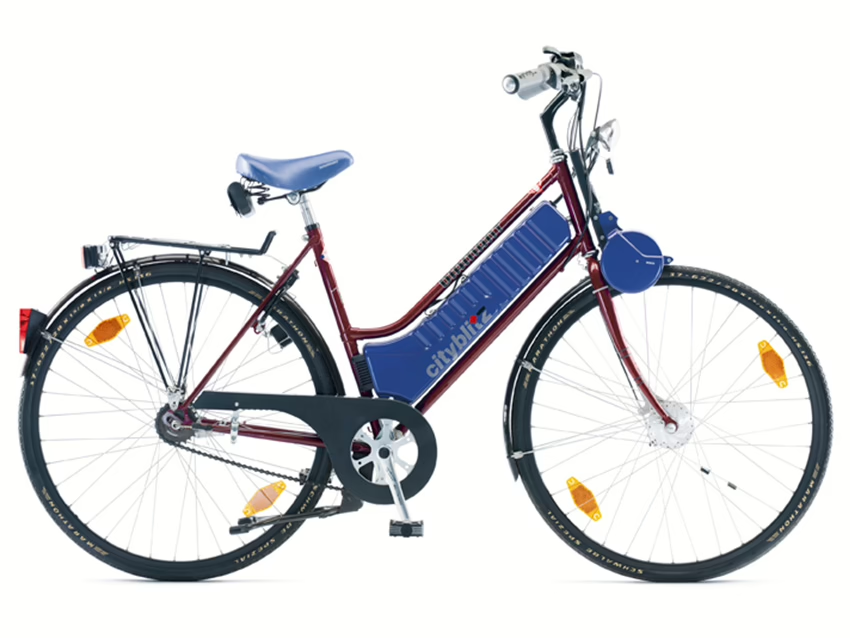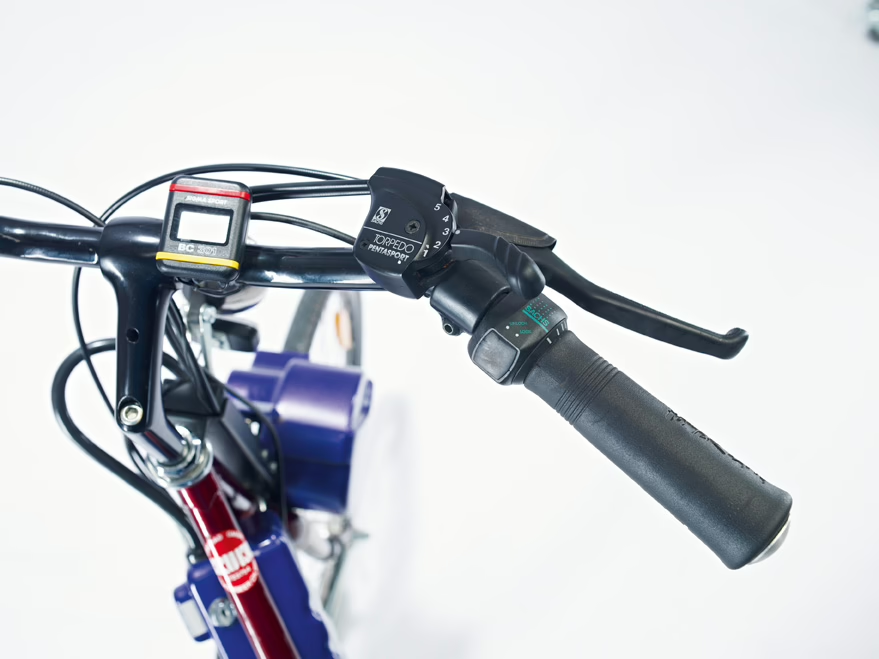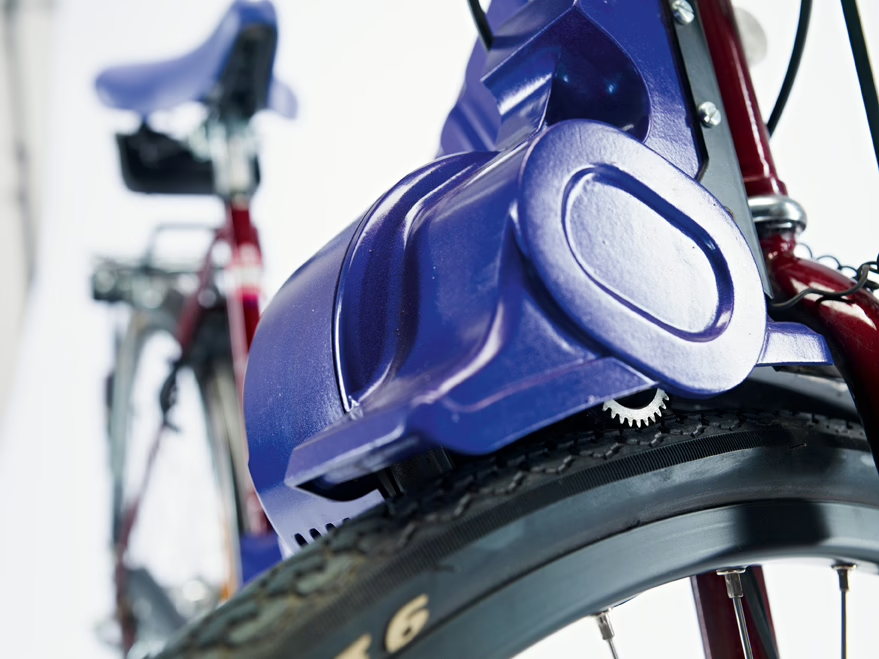
Diamant City Blitz: The second german e-bike
Diamant can innovate. We were the first German manufacturer to experiment with aluminium back in the 1920s. We made the quick release for wheels possible on the road bike at the same time as Campagnolo. And in 1992 we brought our first e-bike into series production – the second German manufacturer ever to do so. Here we take a closer look at the special Diamant City Blitz and its features.
Diamant City Blitz: A steel steed that unlocks powers when your strength wanes
Cycling can be tiring. The idea of working with auxiliary motors is almost as old as the bicycle itself. When the combustion engine was still competing with the steam engine, resourceful people also experimented with electric drives – unsuccessfully at the time. Serious attempts were made in the 1960s, but no prototype ever made it to series production. This changed in the early 90s – an here Diamant was right at the forefront. And certainly at the forefront was the look, which was clearly different from other bicycles. The extravagant colour scheme concealed the large battery as a style element.

“Do you like cycling, but want to take the strain off your muscles? And don’t get out of breath so quickly? There is now an answer to this: City Blitz, the power bike.” This is how the new lightweight moped was advertised from the end of 1991. It was supposed to combine the characteristics of a trekking® bike and a moped. No annoying rattling as with a combustion engine, but more fun for a longer period of time.

The City Blitz was developed in the early 90s with trust funds.* At that time, the pre-produced Hercules Electra had already been on the market for three years – but apart from Diamant, no other manufacturer jumped on the trend. This is why the City Blitz was the second German e-bike in 1992 and also one of only three series products available worldwide.
Mid step, 5-speed Pentasport gear shift and 90s colour design. (Purple and turquoise were an unrivalled cult combination, weren’t they?) The City Blitz was able to show what it was made of on the climbs. A quick turn on the ignition key and a small movement of the handlebar grip set the electric motor on the front wheel in motion. You could let the motor do all the work for you or assist it by pedalling – the Lex Hercules allowed purely motorised assistance up to 20 km/h. The speed was infinitely variable by means of a twist grip. A display on the handlebar showed speed, average speed, distance travelled and even the time. Depending on the equipment, the e-bike cost between 2,550 and 2,800 DM.

The 28.8 V motor acted on the front wheel via friction. It was engaged via a twist grip by a mechanism that lowered it and made contact with the tire. The motor developed a continuous output of 0.17 kw and even 0.36 kw was available for a short time. The engine power was therefore not outstanding, but sufficient for a speed of 20 km/h. It was powered by a 5,3 kg nickel-cadmium battery, which was together with the charger in a lockable, removable box.

Depending on the conditions, one battery charge was enough for around 30 kilometres. That was phenomenal for those days – and as long as the engine wasn’t switched on, the bike could be ridden normally without any friction. The battery was fully charged again after a maximum charging time of four hours.
The pedals and motor of the City Blitz could be completely decoupled. This meant that the e-bike could also be used as a normal bicycle or as a moped. With a weight of 27 kg, the City Blitz was far below other e-bike experiments of the time, but it was certainly not pure pleasure. If you left the power box at home, the City Blitz still weighed 19.2 kg – about 2-3 kg more than a comparable standard bike.
Technical data:
Frame: Light, stable trekking frame
Wheels: Aluminium, black, 28 inch, 37 mm wide
Brakes:
- Front Fichtel & Sachs drum brakes
- Rear 5-speed gear shift from Fichtel & Sachs
- Lighting: Automatic parking light from Union, black
Motor:
- Powerful, switchable electric motor on the front wheel
- Rated voltage 28.8 V
- Continuous power 0.17 kw
- Short term power 0.36 kw
- Rated speed 4200 rpm
- Max. torque 3,2 Nm
Battery:
- Ni-Cd system
- Weight: 5,3 kg
- Rated voltage 28.8 V
- Capacity 7 Ah
- Peak power 30 A
- Max. charging time 3 hours
- Power box removable
Range: 30 km
Top speed: 20 km/h
Weight: 25 kg
Colours:
- Green/ purple
- Silver metallic/ lilac
Display function:
- Speed
- Daily and total kilometres
- Average speed
- Stopwatch
- Battery status
Other:
- Suspension saddle
- Trelock ring lock
- Key switch for motor
- Side stand
- Air pump
Why the Diamant City Blitz failed despite brilliant technology
The City Blitz had a few points, including the friction roller drive. The friction roller, which was too narrow, had hardly any friction when wet and tended to slip. The narrow roller also damaged the front tire with its edges in the long run – so the front tire broke more quickly and was prone to punctures.
Another weak point was the battery. They had a pronounced memory effect, meaning that the battery had to be replaced with a new one after a short time (sometimes after just one year).
Not least because of these defects, the City Blitz did not catch on. The Production was discontinued in 1996. Until then, only 3,000 bicycles had been sold – originally this was the planned quantity for 1992 only. Even if the frame and the rest of the technology were very good: Drive ideas from other manufacturers prevailed on the e-bike.
*The Treuhand agency was an institution under public law whose task was to transfer former state-owned enterprises of the GDR into the private sector. The Treuhand agency invested in the restructuring of the companies before the sale and was supposed to finance itself with the sales proceeds, but in reality needed large state subsidies.